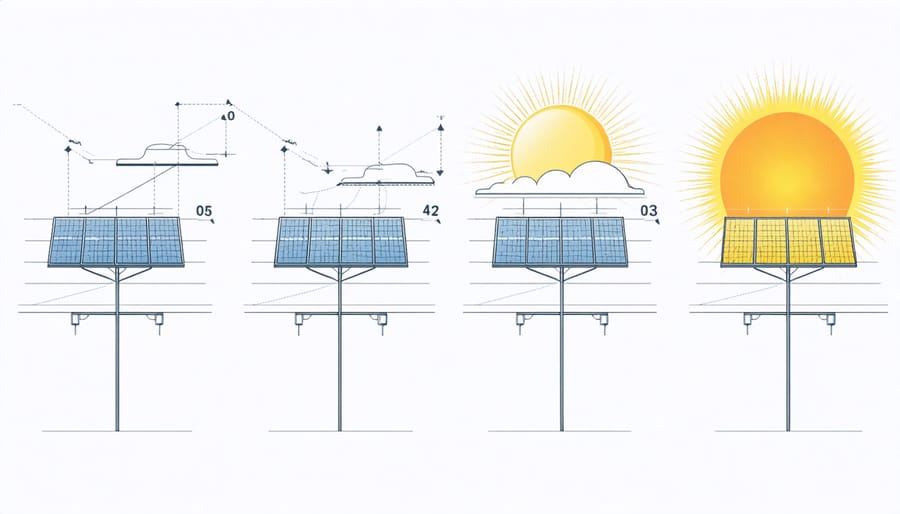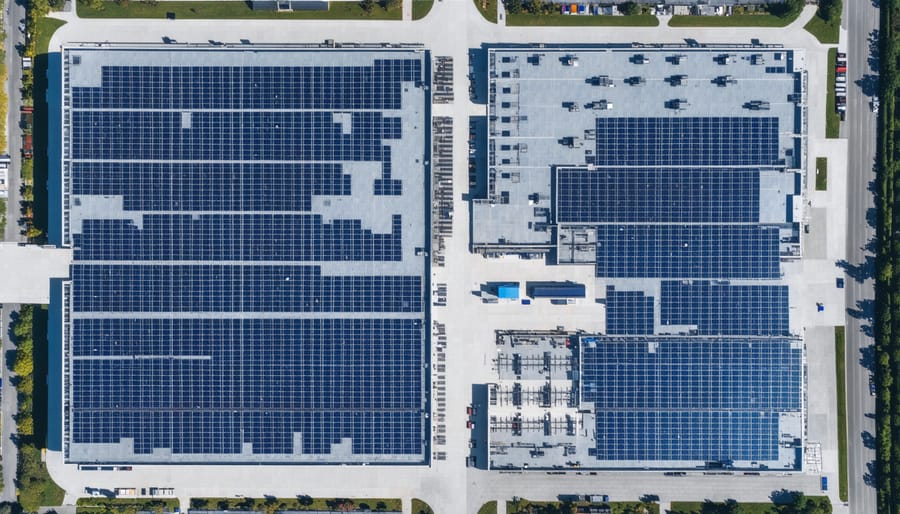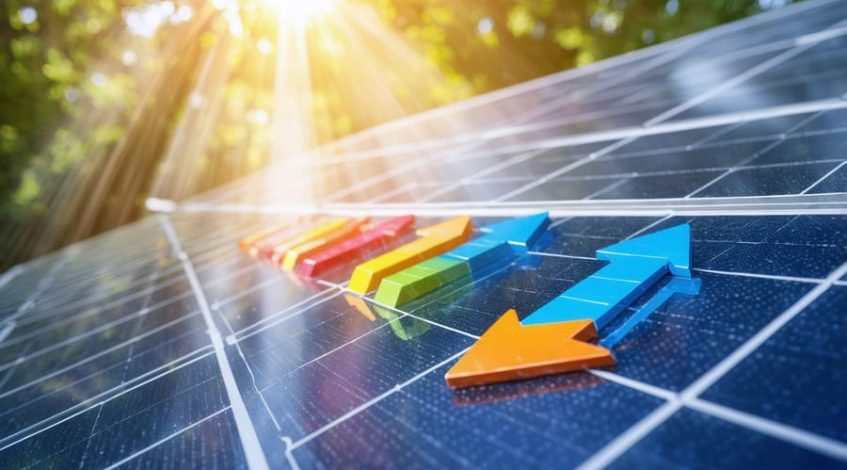Solar panel implementation drives substantial business value, offering organizations the opportunity to maximize savings and performance while meeting growing sustainability demands. Recent data reveals commercial solar installations deliver an average ROI of 15-20% annually, with payback periods typically ranging from 3-7 years depending on facility size and energy consumption patterns.
Leading organizations leverage solar technology not just for cost reduction, but as a strategic asset that enhances operational resilience and strengthens market position. From manufacturing facilities reducing peak load charges to distribution centers achieving energy independence, solar adoption represents a proven pathway to operational excellence and environmental leadership.
This comprehensive guide examines critical factors in solar panel selection, implementation strategies, and optimization techniques that drive measurable business results. Drawing from extensive industry research and successful case studies, we’ll explore how facility managers and business leaders can effectively evaluate, deploy, and maintain solar installations that deliver lasting value while supporting corporate sustainability objectives.
Key Factors in Commercial Solar Panel Selection
Panel Efficiency and Power Output
Modern commercial solar panels typically achieve panel efficiency ratings between 15% and 23%, with premium models reaching up to 25%. These efficiency levels directly impact power output, which is measured in watts per square meter (W/m²). For commercial installations, power tolerance ratings of +/-3% have become the industry standard, ensuring consistent performance and reliable energy generation.
High-efficiency panels can generate between 400W to 600W per panel under optimal conditions, translating to significant energy savings for businesses. Temperature coefficients, typically ranging from -0.3% to -0.5% per degree Celsius above standard testing conditions (25°C), play a crucial role in real-world performance. Lower coefficients indicate better heat tolerance and more stable output in varying weather conditions.
Performance metrics such as degradation rate (commonly 0.5% to 0.8% annually) and Performance Ratio (PR) of 80% or higher help businesses forecast long-term energy yields and calculate return on investment. Modern panels maintain at least 80% of their rated output even after 25 years, providing reliable power generation throughout their operational lifetime.

Durability and Warranty Coverage
Modern solar panels are engineered to withstand diverse weather conditions and typically last 25-30 years with minimal maintenance. Premium manufacturers construct their panels using tempered glass and robust aluminum frames, enabling them to withstand heavy snow loads, hail impacts, and high winds up to 140 mph.
Most tier-1 solar panel manufacturers offer comprehensive warranty coverage that includes both product and performance guarantees. The standard product warranty covers manufacturing defects and material issues for 10-12 years, while performance warranties guarantee at least 80% of rated power output for 25 years. Some premium manufacturers extend these warranties to 25 years for products and 30 years for performance.
Panel degradation rates average 0.5% to 0.8% annually, meaning a quality solar installation will maintain high efficiency throughout its operational lifetime. Environmental factors such as extreme temperatures, salt spray in coastal areas, and pollution levels can influence durability, making proper installation and regular maintenance crucial for maximizing panel lifespan and maintaining warranty coverage.
When selecting panels, businesses should evaluate warranty terms, manufacturer reputation, and third-party testing certifications to ensure long-term reliability and investment protection.
Space Utilization and Installation Requirements
Proper space utilization and installation requirements are critical factors in maximizing solar panel efficiency and return on investment. A typical commercial installation requires approximately 100 square feet of roof space per kilowatt of solar capacity. Before proceeding with installation, facility managers must conduct a thorough structural assessment to ensure the roof can support the additional weight, typically 2-4 pounds per square foot.
Optimal panel placement requires unobstructed southern exposure in the Northern Hemisphere, with a tilt angle matching the installation site’s latitude. Shading from nearby structures, trees, or equipment must be evaluated, as even partial shade can significantly reduce system performance. Allow sufficient spacing between panel rows to prevent self-shading and accommodate maintenance access.
For ground-mounted installations, consider land grading requirements and soil stability. Rooftop installations must account for existing HVAC equipment, vents, and access points. Local building codes and setback requirements may affect panel layout and maximum system size. Professional site surveys can identify potential challenges and optimize available space utilization, ensuring maximum energy generation potential while maintaining building safety and functionality.
Optimizing Solar Panel Performance
Optimal Panel Positioning and Angle
Optimal panel positioning is crucial for maximizing solar energy generation and achieving the best return on investment. For facilities in the Northern Hemisphere, panels should face true south, while Southern Hemisphere installations require northern orientation. The ideal tilt angle typically matches the installation site’s latitude, with adjustments of ±15 degrees depending on seasonal requirements and local climate conditions.
Commercial installations benefit from a fixed tilt angle between 30-45 degrees in most regions, striking a balance between maximum annual energy yield and self-cleaning capabilities. Coastal facilities may require steeper angles (35-40 degrees) to minimize salt spray accumulation, while inland locations can optimize for pure solar exposure with shallower angles (25-30 degrees).
Modern mounting systems allow for precision adjustment, ensuring panels maintain optimal exposure throughout the day. Single-axis tracking systems can increase energy yield by 25-35%, while dual-axis systems offer up to 40% improvement, though these require additional maintenance consideration.
For flat commercial roofs, ballasted racking systems typically space rows to prevent inter-row shading, with a general rule of maintaining a distance of 2.5 times the panel height between rows. This configuration typically results in a power density of 8-10 watts per square foot of roof area.

Maintenance Best Practices
Regular maintenance best practices are crucial for maximizing the efficiency and longevity of your solar panel installation. Implement a quarterly cleaning schedule using deionized water and soft-bristled brushes to remove dust, debris, and bird droppings. During cleaning, inspect panels for microcracks, delamination, or discoloration that might indicate performance issues.
Monitor system performance through your inverter’s data logging system daily, comparing actual output against expected generation. Any significant discrepancies should trigger immediate professional inspection. Trim surrounding vegetation regularly to prevent shading and ensure proper airflow around panels.
Annual professional maintenance should include:
– Thermal imaging to detect hot spots
– Connection tightness verification
– Inverter performance assessment
– Mounting system integrity check
– Wiring insulation inspection
Document all maintenance activities and system performance metrics in a dedicated log. This data helps track degradation patterns and optimize maintenance intervals. During winter months, clear snow accumulation promptly using appropriate tools to prevent load stress and output reduction.
For commercial installations, consider implementing predictive maintenance protocols using IoT sensors and automated monitoring systems. These technologies can alert facility managers to potential issues before they impact system performance, reducing downtime and maintaining optimal energy generation levels.
Performance Monitoring Systems
Performance monitoring systems are essential tools for maximizing the efficiency and return on investment of solar panel installations. Modern monitoring solutions combine advanced sensors, data analytics, and real-time reporting to provide comprehensive insights into system performance.
These systems typically track key metrics including energy production, panel efficiency, voltage levels, and environmental conditions. Web-based dashboards and mobile applications enable facility managers to access performance data remotely, receiving instant alerts about potential issues or maintenance requirements.
Advanced monitoring platforms incorporate machine learning algorithms to predict maintenance needs and optimize energy production. These systems can identify underperforming panels, detect shading issues, and analyze weather impact on system efficiency. By comparing actual performance against expected output, operators can quickly identify and address any deviations.
Data logging and reporting features allow organizations to generate detailed performance reports, helping demonstrate ROI and compliance with renewable energy incentive programs. Many systems also integrate with building management platforms, enabling comprehensive energy management across facilities.
For large commercial installations, monitoring systems often include string-level analysis capabilities, allowing precise identification of performance issues down to specific panel groups. This granular monitoring reduces maintenance costs and minimizes system downtime.
When selecting a monitoring system, consider factors such as data storage capacity, reporting capabilities, alert systems, and integration options with existing facility management tools. The most effective solutions provide both detailed technical data for maintenance teams and simplified performance metrics for management review.
Real-World Implementation Success Stories

Manufacturing Facility Case Study
In 2021, the Smithfield Manufacturing Complex in Colorado implemented a comprehensive solar energy system that serves as a benchmark for industrial solar adoption. The 50,000-square-foot facility, which specializes in automotive parts production, installed a 1.2MW solar array consisting of 3,600 high-efficiency panels across their roof space and adjacent ground-mounted arrays.
The initial investment of $2.4 million was offset by federal tax incentives and state-level renewable energy credits, reducing the net cost to $1.6 million. The system generates approximately 1.8 million kWh annually, covering 75% of the facility’s total energy requirements and resulting in average monthly savings of $15,000 on utility bills.
Key implementation challenges included optimizing panel placement to maximize exposure while maintaining roof integrity and ensuring minimal disruption to manufacturing operations during installation. The facility partnered with local contractors to complete the installation over twelve weeks, scheduling major work during planned maintenance periods.
The system’s sophisticated monitoring infrastructure tracks performance metrics in real-time, allowing facility managers to optimize energy usage patterns. After 18 months of operation, the facility reported a 68% reduction in carbon emissions and projects a complete return on investment within 6.5 years.
Additionally, the installation has improved the facility’s resilience to grid disruptions through integrated battery storage systems, providing up to 8 hours of critical operations backup power. The success of this implementation has led to the company planning similar installations across their other manufacturing locations, with three more facilities scheduled for solar conversion by 2024.
Office Complex Solar Solution
The Capital Plaza office complex in downtown Denver serves as a prime example of successful commercial solar integration, demonstrating both environmental leadership and financial acumen. In 2020, this 12-story, 280,000-square-foot building underwent a comprehensive solar installation that transformed its energy consumption profile and operational costs.
The project involved installing 892 high-efficiency solar panels across the building’s roof space and south-facing facade, utilizing innovative bifacial technology to capture both direct sunlight and reflected light from surrounding surfaces. This strategic placement maximizes energy generation while maintaining the building’s architectural integrity.
The system generates approximately 425,000 kWh of electricity annually, covering 47% of the building’s total energy needs. This substantial energy offset has resulted in average monthly utility savings of $12,500, with peak savings reaching $18,000 during summer months. The initial investment of $875,000 was partially offset by federal tax incentives and local green energy grants, resulting in a projected ROI period of just 4.8 years.
Beyond financial benefits, the installation has enhanced the property’s market value and tenant satisfaction. Surveys indicate that 82% of tenants report improved workplace satisfaction, citing their company’s contribution to sustainability as a key factor. The building has achieved LEED Gold certification and serves as a model for other commercial properties in the region.
The project’s success has prompted neighboring buildings to explore similar solutions, creating a ripple effect in the commercial real estate sector. The Capital Plaza case demonstrates how thoughtful solar integration can deliver both immediate cost savings and long-term strategic advantages for office properties.
As we’ve explored throughout this article, solar panel adoption represents a strategic investment that delivers both environmental and economic benefits for organizations of all sizes. The evidence clearly demonstrates that solar energy has evolved from an alternative power source to a mainstream solution for businesses seeking to reduce operational costs and enhance sustainability credentials.
The dramatic decrease in solar panel costs, combined with improved efficiency and reliability, has created an unprecedented opportunity for businesses to transform their energy infrastructure. With potential ROI periods shortening to 5-7 years in many regions, and systems lasting 25-30 years, the financial argument for solar adoption has never been stronger.
Key considerations for successful implementation include thorough site assessment, proper system sizing, quality equipment selection, and engagement with experienced installers. Organizations that have successfully deployed solar solutions consistently report reduced energy costs, improved operational resilience, and enhanced brand value through demonstrated environmental leadership.
Looking ahead, the solar industry continues to innovate, with new technologies and financing options making adoption increasingly accessible. Government incentives, tax benefits, and renewable energy credits further strengthen the business case for solar investment.
For decision-makers considering solar implementation, the time to act is now. We encourage you to begin with an energy audit of your facility, engage with qualified solar providers, and develop a comprehensive solar strategy aligned with your organization’s goals. By taking these steps today, you position your organization to capture the full spectrum of benefits that solar energy offers while contributing to a more sustainable future.
Remember, successful solar adoption requires careful planning and execution, but the long-term rewards make it a compelling investment for forward-thinking organizations.

